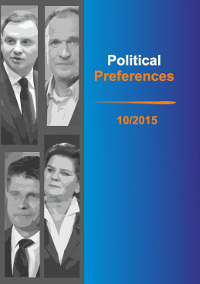

Support the candidate by the party leader and the decisions of voters. Electoral study
Competition in the elections makes it necessary for the participants to seek different ways of standing out from the others. One of the ways is to utilize the rule of the authority. The mechanism of the irradiation technique causes positive feelings to radiate from a person well-known to and respected byan electorate onto a less well-known person but connected with the former even through having a photo together. The aim of the paper is to show what position those polled took on the issue of using the rule of the authority in the election campaigns in 2014. The results of surveys conducted in the autumn of 2014 clearly show which party electorates are prone to be influenced by this type of advertising, whether by being directly told by the party leader which candidate should be voted for, or by the candidate's photo together with the party leader or chairman.
Key words:
election campaign, election advertising, irradiation technique
Download files
Citation rules

No. 10 (2015)
Published: 2015-01-01
 10.31261/polpre
10.31261/polpre